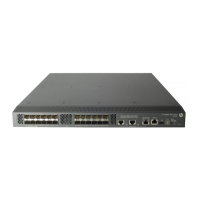35
Configuring common settings for console login (optional)
CAUTION:
The common settings configured for console login take effect immediately. If you configure the common
settin
s after you lo
in throu
h the console port, the current connection may be interrupted, so you should
use another login method. After you configure common settings for console login, you must modify the
settings on the terminal to make them consistent with those on the device.
Ste
Command
Remarks
1. Enter system view.
system-view —
2. Enable display of copyright
information.
copyright-info enable
Optional.
Enabled by default.
3. Enter AUX user interface view.
user-interface aux
first-number
[ last-number ]
—
4. Configure
AUX user
interface
view
properties.
Configure baud
rate.
speed speed-value
Optional.
By default, the transmission rate is 9600 bps.
Transmission rate is the number of bits that the
device transmits to the terminal per second.
Configure parity
check mode.
parity { even | mark |
none | odd | space }
Optional.
none by default.
Configure stop
bits.
stopbits { 1 | 1.5 | 2 }
Optional.
By default, the stop bit of the console port is 1.
Stop bits are the last bits transmitted in data
transmission to unequivocally indicate the end
of a character. The more the bits are, the
slower the transmission is.
Configure data
bits.
databits { 5 | 6 | 7 |
8 }
Optional.
By default, the data bit of the console port is 8.
Data bits is the number of bits representing
one character. The setting depends on the
contexts to be transmitted. For example, set it
to 7 if standard ASCII characters are to be
sent, and set it to 8 if extended ASCII
characters are to be sent.
Define shortcut
key for enabling
a terminal
session.
activation-key
character
Optional.
By default, press Enter to enable a terminal
session.
Define shortcut
key for
terminating
tasks.
escape-key { default |
character }
Optional.
By default, press Ctrl+C to terminate a task.

